Topics 2020
December
Biodiesel Fuel Sea Trial Carried Out Successfully at the Port of Nagoya
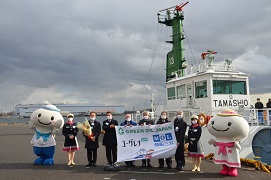
On December 14, biofuel made by euglena Co., Ltd. at its demonstration plant in Yokohama was used in a tugboat at Garden Pier in the Port of Nagoya. After a ceremony, the tugboat 13 Tamashio, owned and operated by MOL Group company Green Kaiji Kaisha, Ltd. conducted a sea trial using the environmentally friendly fuel.
The euglena biodiesel fuel used in the test is a low-environmental impact fuel made from used cooking oil and Euglena, a type of algae.

November
The Deputy Chief of Mission for U.S. Embassy Tokyo visits the Port of Nagoya

The Deputy Chief of Mission for the U.S. Embassy, Mr. Nicholas M. Hill, and the Principal Officer of the U.S. Consulate Nagoya, Mr. Gary Schaefer, visited the Port of Nagoya on November 19. They inspected the port and exchanged information on board the ship.
The cruise ship Nippon Maru calls at the Port of Nagoya

The cruise ship Nippon Maru called at the Port of Nagoya on the morning of November 18. This was the first time the ship had called at Nagoya since last December because of the Covid-19 pandemic.
To resume receiving cruise ships, the Nagoya Port Authority made a manual for the prevention of the spread of Covid-19 when cruise ships enter the port. The Japan Oceangoing Passenger Ship Association (JOPA) has also made guidelines for infection control onboard cruise ships and at passenger terminal on which cruise ships berth.

October
“Nagoya Art Fireworks Festival 2020” held at the Port of Nagoya

The “Nagoya Art Fireworks Festival 2020” was held at Garden Pier on October 24. The event took place to express our gratitude and respect for all medical workers, while taking measures to prevent the spread of Covid-19 infection.
Environmental Initiatives at the Port of Nagoya
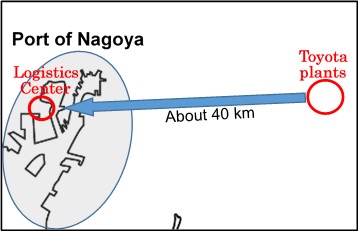
At the Port of Nagoya, we have been working to reduce our environmental impact by proactively protecting the natural environment and reducing CO2 emissions through such means as wind and solar power generation. We participated in the Green Award Program in 2016 in order to promote environmental protection and safe vessel operations at the port, and now offer incentives to certified vessels. In November 2019, the first bunkering experiment on an LNG-fueled tug boat was successfully performed at the Port of Nagoya.
Toyota Motor Corporation, one of the major clients of the Port of Nagoya, has recently announced that they will start on-the-road trials of heavy-duty fuel cell electric trucks in the spring of 2022. They will use these trucks to transport automotive parts between Toyota plants located around 40km from the port and their Logistics Center in the port area.
For more information https://global.toyota/en/newsroom/corporate/33952136.html
We will continue to focus on environmental sustainability while striving for competitive port operations.
Expansion of emergency business assistance during the novel coronavirus pandemic
The Nagoya Port Authority is taking additional measures to assist port businesses in response to the escalation of the COVID-19 pandemic.
The port has already allowed all users to defer the payment of usage fees incurred between April and December. The target period has now been extended to March 2021 and the due date for the usage fees incurred since April of this year has also been extended.
The deadline for payment is now set on April 30th, 2021.
September
First call of newly-built RORO ship the Shinsen Maru at the Port of Nagoya

On September 14th, the newly-built RORO ship Shinsen Maru (Gross Tonnage: 14,054 t, LOA: 174.95 m), which is operated by Kuribayashi Steamship Company, Ltd., made its first call at the Port of Nagoya. At the Inae Pier a welcome ceremony was held with measures to prevent the spread of the Covid-19 infection.
The vessel can carry 150 trailers, 250 new and used automobiles and 2,000 rolls of paper at the same time and connects Tomakomai and Kushiro in the Hokkaido region, Sendai in the Tohoku region, Tokyo and Nagoya.
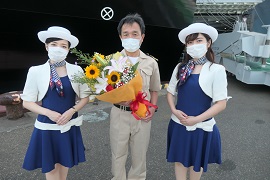
August
22-row-outreach gantry cranes will be installed at NCB Container Terminal
The Nagoya-Yokkaichi International Port Corporation (NYP) is replacing two old gantry cranes at the NCB Container terminal with two new ones. The new cranes’ outreach is 61 meters and they can handle containers up to 8 tiers high above deck and 22 rows in breadth on a container ship. The rated capacity of the cranes is 61 metric tons (container) and they are equipped with twin spreaders and seismic isolation devices.
At the NCB terminal “Tobishima Pier Reorganization and Improvement Project” is underway to redevelop the existing berths in response to the deterioration of the berths and the growth in containership size. The new berths are going to have a deeper water depth and be quake-resistant. On completion of the project, berths of 15 meters in depth and 1,400 meters straight in total length (350 m x 2 berths at Tobishima Pier South Container Terminal and 350 m x 2 berths at NCB Container Terminal) will be in service on the east side of Tobishima Pier.
Gantry Crane replaced at Tobishima Pier South Container Terminal
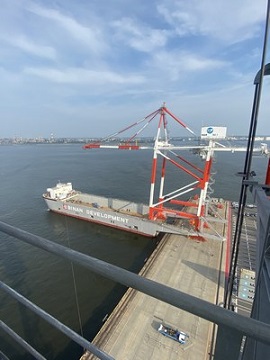
The Nagoya-Yokkaichi International Port Corporation (NYP) installed a new 20-row-outreach gantry crane at Tobishima Pier South Container Terminal. In response to the growth in containership size, NYP has been replacing gantry cranes at the pier, where four out of six cranes have been upgraded to 20-row-outreach cranes.
The replaced gantry crane was lifted by a floating crane and taken away to a vacant lot in the port where it will be dismantled.

July
Nagoya Port Authority achieved 20 percent reduction in GHG emissions in 2019
The Nagoya Port Authority is reducing greenhouse gas emissions based on the “Nagoya Port Authority 4th Anti-Global Warming Measures Execution Plan,” which was formulated in July 2017 with the target year of 2021.
In 2019, the total GHG emissions from NPA amounted to 12,114 tons (converted amount of carbon dioxide). This figure was a 20.3 percent reduction compared to the base year of 2013.
The target for GHG emissions reduction in the plan is 14 percent in 2021 from the base year. The 2019 result exceeded the target thanks to efforts such as replacement of vehicles with more fuel efficient models, introduction of low emission vessels, economical navigation by port authority boats, facility upgrades, electricity conservation, streamlining of organizational structure and unification of branch offices.
The Nagoya Port Authority continues to wrestle with the problem of GHG reductions to achieve the long-term goal of a 26 percent cut in 2030 compared with the base year.
Expansion of emergency business assistance during the novel coronavirus pandemic
The Nagoya Port Authority is taking additional assistance measures for port businesses in response to the escalation of the COVID-19 pandemic. So far the port has allowed small and medium-sized companies to defer usage fees incurred between April and September for a maximum of 6 months. Now the period is extended to December and the assistance is applied to all users.
May
Expansion of emergency business assistance during the novel coronavirus pandemic
The Nagoya Port Authority has announced an expansion of the emergency business assistance measures associated with the spread of the novel coronavirus. In addition to the assistance measures that have continued since April, we are giving small and medium-sized companies affected by the novel coronavirus a 6-month grace period for payment of land and other lease fees (target period: until September), to lessen their burden.
April
Face masks received from China Ports and Harbours Association
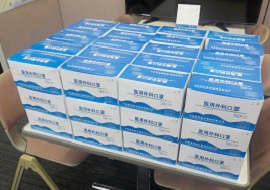
As the novel coronavirus continues to spread throughout the world, including Japan, the Nagoya Port Authority received 3,000 face masks from the China Ports and Harbours Association in April. These face masks are all being used as an emergency response measure for staff working at international piers and related parties.
When the novel coronavirus was spreading in China in February 2020, the Nagoya Port Authority donated stockpiled face masks to Shanghai International Port (Group) Co., Ltd. and China Ports and Harbours Association, with whom we conduct personnel exchange programs.
Emergency business assistance during the novel coronavirus pandemic
The Nagoya Port Authority has announced an emergency business assistance measure associated with the spread of the novel coronavirus. We are giving small and medium-sized companies affected by the novel coronavirus a 6-month grace period for payment of port facility usage fees, port dues, water surface usage fee and administrative assets special fees, from April until September in 2020, to try to lessen their burden. The Port of Nagoya will continue to conduct port operations.
February
Conclusion of Memorandum of Understanding (“MOU”) with The Port of Los Angeles

The Port of Nagoya has marked 60 years of sister port relations with the Port of Los Angeles. On this occasion, the Parties confirmed that they would continue to advance their cooperative relationship and entered into MOU regarding mutual cooperation in the areas of environmental sustainability and efficiency. This MOU was signed by Mr. Eugene D. Seroka, Executive Director, the Port of Los Angeles on 20th February, and by Mr. Hideaki OHMURA, President, Nagoya Port Authority, Governor of Aichi Prefecture on 25th February. In this MOU, the Parties have agreed to cooperate in developing and deploying port community systems and a platform to share end-to-end supply chain information, and in developing and deploying zero-emission vehicles and equipment. They will also undertake innovative partnerships, initiatives, and other activities that can further their mutual priorities.
